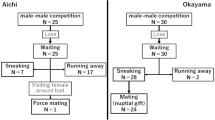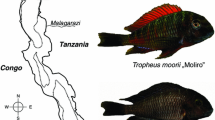Summary
In the lek-breeding great snipe, male morphology, behaviour, and territory features were recorded for individually marked birds on two adjacent leks. Partial correlation sshowed that male mating success, expressed as the number of female solicitations and copulations, was negatively correlated with the distance of a display territory to the lek center and positively correlated with the number of displays per unit time given by a male. No other variables were directly correlated with male matin success. Thus, central males obtain more matings than peripheral males and successful males display more per unit time than do less successful males, independently of position on the lek. Central males were found to be older than peripheral ones and were present more often on the lek. Furthermore, central males had a larger number of white tail feathers, which are usea as visual signals in the displays, but this may be explained by the fact that these males were older. It is suggested that male great snipe are subject to sexual selection mainly in behavioural and vocal cues and that this may explain the absence of size and plumage dimorphism in this species.
Similar content being viewed by others
References
Andersson M (1982) Sexual selection, natural selection and quality advertisment. Biol J Linn Soc 17:375–393
Avery M, Sherwood G (1982) The lekking behaviour of Great snipe. Ornis Scand 13:72–78
Ballard WB, Robel RJ (1974) Reproductive importance of dominant male greater prairie chickens. Auk 91:75–85
Bradbury JW (1981) The evolution of leks. In: Alexander RD, Tinkle DW (eds) Natural selection and social behaviour, recent research and new theory. Chiron Press, New York, pp 138–173
Darwin C (1871) The descent of man and selection in relation to sex. Murray, London
Davies NB (1978) Ecological questions about territorial behaviour. In: Krebs JR, Davies NB (eds) Behavioural ecology, an evolutionary approach. Blackwell, London, pp 317–351
Elveland J, Tjernberg M (1984) Vegetationsförhållanden på några spelplaster för dubbelbeckasin (Gallinago media) i västra Härjedalen och södra Lappland. (The vegetation on some display grounds of the great snipe, Gallinago media, in Sweden.). Memoranda Soc Fauna Flora Fennica 60:125–140
Ferdinand L (1966) Display of the great snipe (Gallinago media Latham). Dansk Orn Foren Tidskr 60:14–34
Ferdinand L, Gensbol B (1966) Maintenance of terriotory in the Great snipe (Gallinago media Latham) on the display ground. Dansk Orn For Tidskr 60:35–43
Gibson RM, Bradbury JW (1985) Sexual selection in lekking sage grouse: phenotypic correlates of male mating success. Bchav Ecol Sociobiol 18:117–123
Gilliard ET (1962) On the breeding behaviour of the cock-of-the-rock (Aves, Rupicola rupicola). Bull Am Mus Nat Hist 124:31–68
Hjorth I (1970) Reproductive behaviour in Tetraonidae, with special reference to males. Viltrevy 7:183–596
Hogan-Warburg AJ (1966) Social behaviour of the ruff Philomachus pugnax (L.). Ardea 54:109–229
James FC, McCulloch CE (1985) Data analysis and the design of experiments in ornithology. In: Johnston RF (ed) Current ornithology, vol 2. Plenum Press, New York, pp 1–63
Kirkpatrick M (1982) Sexual selection and the evolution of female choice. Evolution 36:1–12
Kruijt JP, Vos GJ de, Bossema I (1972) The arena system of the black grouse (Lyrurus tetrix (L.)). Proceedings of the 15th International Ornithological Congress, pp 399–423
Lande R (1981) Models of speciation by sexual selection on polygenic traits. Proc Nat Acad Sci USA 78:3721–3725
Lemnell PA (1978) Social behaviour of the great snipe Capella media at the arena display. Ornis Scand 9:146–163
Lill A (1974a) Social organisation and space utilization in the lek forming white-bearded manakin, M. manacus trinitatis Hartert. Z Tierpsychol 36:513–530
Lill A (1974b) Sexual behaviour of the lek-forming whitebearded manakin (Manacus manacus trinitatis Hartert). Z Tierpsychol 36:1–36
Lill A (1976) Lek behaviour in the golden-headed manakin, Pipra erytrocephala, in Trinidad (West Indies). Z Tierpsychol Supplement 18:1–83
Moyles DLJ, Boag DA (1981) Where, when and how male sharp tailed grouse establish territories on arenas. Can J Zool 59:1576–1581
O'Donald P (1980) Genetic models of sexual selection. Cambridge Univ Press, Cambridge
Parker GA (1982) Phenotype-limited evolutionary stable strategies. In: Bertram BR, Clutton-Brock TH, Dunbar RIM, Rubenstein DI, Wrangham R (eds) Current problems in sociobiology. Cambridge Univ Press, Cambridge
Parker GA (1983) Mate quality and mating decisions. In: Bateson P (ed) Mate choice. Cambridge Univ Press, Cambridge, pp 141–166
Payne RB (1984) Sexual selection, lek and arena behaviour, and sexual size dimorphism in birds. Orn Monogr 33:1–52
Prater T, Marchant J, Vuorinen J (1977) Guide to the identification and ageing of holarctic waders. British Trust for Ornithology, Tring
SAS Institute Inc. (1985) SAS user's guide: basics version, 5th ed. SAS Institute, Cary
Shephard JM (1976) Factors influencing female choice in the lek mating system of the ruff. Living Bird 87–111
Swanberg PO (1965) Studies of less familiar birds 138. Great snipe. British Birds 58:504–508
Svensson L (1975) Identification guide to European passerines. Naturhistoriska Riksmuseet, Stockholm
Tuck LM (1972) The snipes: a study of the genus Capella. Can Wildl Serv Monogr Ser 5:1–429
Vos GJ de, Bruinsma OH (1985) Rookoing and mate choice in black grouse; a field study. Poster presented at the 19th International Ethological Conference, Toulouse, France
Wiley RH (1973) Territoriality and non-random mating in Sage grouse, Centrocercus urophasianus. Anim Behav Monogr 6:85–169
Author information
Authors and Affiliations
Rights and permissions
About this article
Cite this article
Höglund, J., Lundberg, A. Sexual selection in a monomorphic lek-breeding bird: correlates of male mating success in the great snipe Gallinago media . Behav Ecol Sociobiol 21, 211–216 (1987). https://doi.org/10.1007/BF00292501
Received:
Accepted:
Issue Date:
DOI: https://doi.org/10.1007/BF00292501




